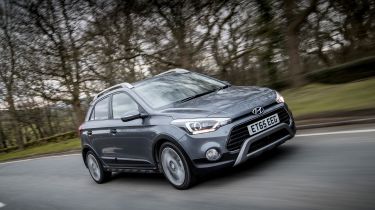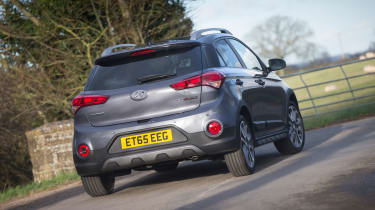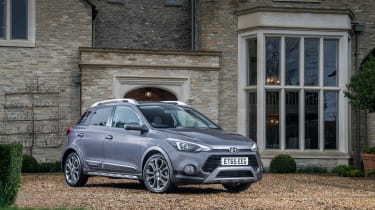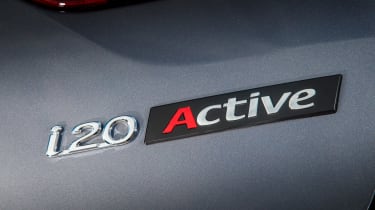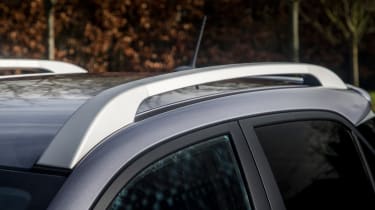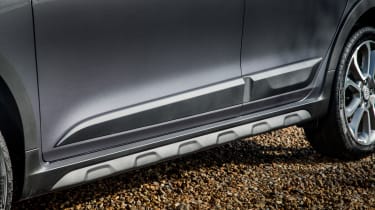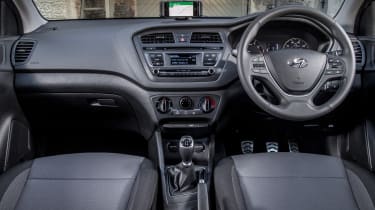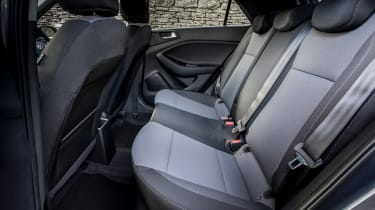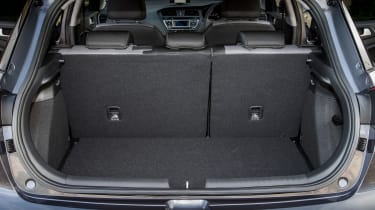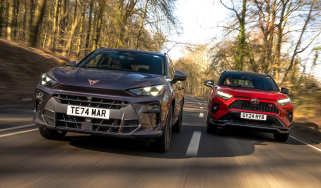Hyundai i20 Active review
The rugged i20 Active is Hyundai's attempt at getting in on the small crossover boom, and it's not a bad choice

Hyundai is close to jumping on the small crossover bandwagon with the new Kona. But for now if you want something smaller than the Tucson (which challenges the best-selling Nissan Qashqai), you'll have to make do with the i20 Active. In theory, it provides what most people are looking for in a car from this class; a raised ride height, more rugged styling and some extra practical touches.
Called the i20 Cross in Asian markets, the i20 Active is aimed at lifestyle buyers who enjoy outdoor sports and activities. But it also faces a challenge from cars like the Suzuki Swift 4x4 and Fiat Panda Cross, both of which offer the same pumped-up styling but also proper four-wheel drive and off-road capability. The i20 Active only comes with front-wheel drive.
It’s a glorified trim level (despite the looks) and is only offered in the UK with front-wheel drive and the new 1.0-litre turbocharged three-cylinder petrol engine. Based on SE spec, it gets a DAB radio, Bluetooth and cruise control as standard. Its price is roughly in line with the Ford EcoSport 1.0-litre Ecoboost.
The Hyundai i20 Active adds to the niche band of jacked-up, rugged-looking superminis. It might not have quite the same authenticity but it’s decent value compared to purpose-built small crossovers. It’s also spacious, fairly well-made and a competent drive.
Used - available now
The problem is, unlike a Renault Captur, which looks very different to a Clio, the Active doesn’t really transform the i20 enough to justify its £1,200 price premium. No four-wheel drive means you may as well plump for the regular supermini and pocket the difference, unless you must have roof rails and body cladding.
Engines, performance and drive
The regular Hyundai i20 is a decent (if unexciting) base for a more rugged version. It’s safe, stable and competent but stops short of ever being as fun as a Ford Fiesta. It’s much the same story with the Active.
The ride height has grown by 20mm over the regular i20, which you’d think would serve to soften the Active’s ride. But engineers tell us the suspension has actually been stiffened over the standard hatch to counteract the increased body roll. That means the body stays fairly flat in the bends compared to a Renault Captur.
Don’t think that it’s been transformed into an agile and engaging small hatch, however. The Active, like the i20, remains a safe and stable rather than fun car to drive. It feels composed in terms of body control, but steering feel is lacking and there’s not a lot of involvement to be found. The stiffening of the suspension combined with the standard fit 17-inch alloys also causes it to feel unsettled over bumpy roads. It’s a shame, because putting smaller wheels on the i20 allows it to become comfortable at all speeds.
Engines
The i20 Active is only available with the new 1.0-litre turbocharged petrol engine that’s just been added across the i20 range. Unfortunately, it’s only in the lower 99bhp state of tune – for some reason European buyers also get the option of a 118bhp version but UK buyers don’t on the Active.
It’s a shame the engine range for the Active is limited compared to the hatch, as an entry-level petrol engine would reduce the price further and a diesel choice would satisfy those looking to do longer distances or carry lots of stuff. We suspect the turbo petrol provides the best profit margin for Hyundai.
All is not lost though, as the 1.0-litre turbo is a very good engine. Despite the relatively low power output it gets a healthy 171Nm of torque, which is enough to get the Active from 0-62mph in 10.9 seconds and on to a 109mph top speed. As with most turbo units, however, it feels stronger than figures suggest in the mid-range and is pretty smooth.
It doesn’t quite have the same low-down zip as you’ll get in Ford’s Ecoboost though, requiring revs to get the best out of it. It also isn’t quite as refined as the similar unit you’ll find in the Vauxhall Corsa.
MPG, CO2 and Running Costs
The i20 Active’s sole engine, the 1.0-litre turbo, is at least considerably more efficient than the 1.4-litre petrol engine it replaces. That old naturally-aspirated unit claimed 51.4mpg, but in the regular i20 the new engine manages over 65mpg.
Unfortunately, the conversion to Active spec reduces that figure significantly. It’s mostly due to the bigger wheels, but the jacked-up body shape is also less efficient. Officially, the combined figure drops down to 58.9mpg, so expect mid forties to be easily achievable in the real-world.
The i20 Active emits 110g/km of CO2, which is competitive considering a Ford EcoSport 1.0T emits 125g/km and the less powerful Renault Captur TCE 90 produces 115g/km. Viewed on that basis it looks strong, but remember that a regular i20 with the same engine sees CO2 drop below 99g/km. At least there’s no four-wheel drive available to drop that figure further.
Insurance groups
Insurance groups have yet to be decided for the i20 Active, but don’t expect it to rise significantly over the group 10 figure for the regular petrol i20. Some supermini rivals offer fractionally cheaper insurance, but the Active should be cheaper than true crossovers such as the Suzuki Vitara and Renault Captur.
Depreciation
As Hyundai’s brand image has improved in recent years, so have the residual value figures of its models. The regular i20 is predicted to retain between 42 and 46 per cent of its value after three years, which is a respectable figure. Expect the i20 Active to be similar (if not better) than this. By comparison, a Fiesta retains around 38 per cent, but an Ecosport is similar at between 42 and 45 per cent.
Interior, design and technology
Hyundai is happy to admit that the i20 Active is an exercise of form over true function, but so are many crossovers on the market. It’s all about providing rugged looks and a mini-SUV style but zero actual off-road ability, and it’s a formula that’s more popular than ever.
The regular i20 is surprisingly well proportioned and good looking, so its no surprise that the Active also has similar appeal but in a slightly more rugged form. Whether or not you think the addition of chunky bumpers and roof rails makes any difference to a supermini is up to you, but current crossover sales levels suggest enough buyers will be seduced to make this a niche worth filling for Hyundai. The Active also gets wheelarch cladding and smart 17-inch alloys to complete the look.
The problem is, true crossovers offer much more in terms of styling differences compared to their supermini relations – for example, a Renault Captur looks significantly different to a Renault Clio even to the untrained eye. The differences between the i20 and i20 Active are altogether harder to discern.
Inside, the i20 Active is totally unchanged from the regular i20, so it’s less about style and more about ease of use. It’s far from unattractive, however, and the cabin is durable and sensibly laid-out. Some of the plastics are hard and scratchy, but it’s all decent quality as we’ve come to expect from Hyundai. The chunky three-spoke steering wheel gets a soft leather covering in Active spec, and while the standard car is a bit dark inside you can spec some brightly coloured door and dash panels from the options list.
Sat-nav, stereo and infotainment
Unfortunately, Active spec does without Hyundai’s new seven-inch colour touchscreen found on flagship models of the regular i20. Worse still, it’s not even available as an option. At least it’s now available with a DAB radio and is very easy to use, with big chunky buttons in a high-up position on the dash.
It’s a shame that the display is a dated-looking dot-matrix affair, however. The standard six-speaker stereo set up is more than adequate for most people, and as you’d expect there’s Bluetooth, USB and Aux connectivity available.
Practicality, comfort and boot space
The compact crossover class is a market sector where practicality plays second-fiddle to style, and that definitely plays in the i20 Active’s favour. The standard i20 is one of the most spacious superminis around, beating a Ford Fiesta and VW Polo for interior space, and the Active inherits the same roominess.
It’s a pleasant surprise, especially given how poor crossover cars like the Nissan Juke are for rear-seat accommodation. Only something like the SsangYong Tivoli offers more space. What is missing from the Active that you find on many crossovers is an elevated driving position, and the Active is only 20mm taller than the regular i20. That may put off some people drawn to small crossovers by the benefit of being higher up. Visibility is pretty good despite this, with large windows all-round giving a good view out.
Storage space inside is also rather impressive. There are generously-sized door bins, plenty of cupholders and a deep glovebox that gets an air-conditioning vent. The boot also gets a variable floor to let you hide objects from sight, although it means that there’s no standard spare wheel.
Size
The Hyundai i20 is one of the biggest superminis available, and the Active is pretty much unchanged in terms of length and width compared to the regular car. It’s just over four metres long, with only the Vauxhall Corsa approaching it for size, and significantly larger than a Fiesta.
However, a number of true crossovers are larger. The Renault Captur is about 100mm longer, which pays dividends inside, while a Kia Soul is similarly larger and cheaper to buy.
Leg room, head room & passenger space
As with the normal i20, the Active is just about the most accommodating supermini in the class. There’s decent room for two adults, with loads of headroom and adequate legroom, while a third rear-seat passenger could squeeze in for short journeys. A crossover like the Kia Soul or Ssangyong Tivoli would be more spacious still, however.
Boot
The i20 gets a 326-litre boot, which is big by supermini standards but merely average compared to some of the chunkier small crossovers around. A Ssangyong Tivoli boasts 420-litres, for example. Yet the low floor and wide opening means what space there is easy to access, while the variable boot floor means it’s flat. 60/40 split folding rear seats are also standard.
Reliability and Safety
Given the lack of mechanical modifications to Active spec on the i20, we’d expect it to be as reliable as the standard car. Hyundai’s reputation gets better and better every year, and the smaller i10 finished an impressive third place in our 2015 Driver Power survey. The only concern is the all-new and unproven three-cylinder turbo engine.
The i20 was a bit too new to feature in the survey, but we’d expect a similarly trouble-free ownership experience. Plus, there’s also the benefit of Hyundai’s five-year warranty, although as a brand the Korean firm finished a rather mediocre 21st place last year.
In terms of safety, the Active is yet to be tested by Euro NCAP, but given the changes amount to little more than some new exterior trim and a raised ride height its unlikely to receive anything less than the four stars the standard car got.
It missed out on the top score simply because of a lack of active safety features, despite lane departure warning being fitted as standard. Pedestrian, adult and child occupancy ratings are all amongst the class best.
Warranty
Hyundai’s five-year, unlimited-mileage warranty may not be quite as long as Kia’s seven-year one, but it covers more things that could go wrong on the car. Given most rivals still offer three-year warranties it’s very good. Alongside this, you get five years of roadside assistance and five years of annual vehicle health checks.
Servicing
Service intervals for the i20 1.0-litre are every 10,000 miles or one year, but Hyundai offers a reasonable three-year service package for £349. Maintenance costs shouldn’t be too steep, and certainly won’t be any different for the Active.
